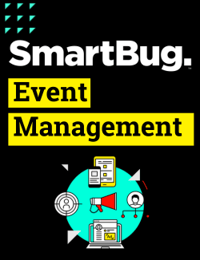
By Julia Bye
Regardless of whether the event lasts a day or a week, trade shows are a whirlwind and require a robust plan of action. Not only does a good plan ensure that everything goes smoothly the day of, but it’s also necessary to maximize lead capture. A successful event is one that, at the minimum, is coordinated and enjoyable, but ideally also secures and converts valuable leads for your business.
Pre-trade show planning should be your attempt to virtually wine and dine your top-tier targets to drive better results once the event rolls around (and, preferably, even after it’s concluded). Let’s get into how you can formulate your plan by leveraging the art of pre-trade show planning in your marketing efforts.
The Importance of Pre-Trade Show Planning
Your plan should set the foundation for a successful trade show experience. If you don’t plan ahead with the right touchpoints for your leads, you may miss a crucial opportunity to engage with them at the event.
Start by establishing clear goals and objectives to guide your specific planning efforts. When it comes to establishing your KPIs, be sure to look at the pre-, during, and post-event efforts as one whole campaign. Generally speaking, the ultimate goal is to tie revenue back to the trade show efforts. This allows marketing and sales teams to decide if the ROI of that specific show is worth the investment. Plus, it helps to develop a more comprehensive event budget.
Planning Deliverables Before the Event
Crafting a robust plan ensures that every potential lead is captured and followed up with promptly, minimizing the risk of missed opportunities. By facilitating one-on-one conversions with representatives before the event, you can enhance engagement and increase the likelihood of conversion.
Some key things to track to capture data and insights from pre-show interactions with attendees include:
- Engagement with forms on landing pages
- Intent data on relevant keywords
- Clicks and form fills through paid advertising
- Open and click rate in emails
This information provides you with further insight into which leads are most engaged and what their pain points are. It allows you to personalize the sales and marketing experience, meaning you’re more likely to secure sales.
Planning ahead enables you to refine the most impactful messaging for designs and assets, ensuring they effectively drive conversations and booth visits, ultimately maximizing ROI. But your event deliverables shouldn’t be just those that you utilize at your booth during the trade show itself.
Building Visibility and Brand Awareness
Brand visibility and awareness often take time to grow, but that doesn’t make your deliverables leading up to the trade show obsolete. Not only can you use strategic planning to build hype for your appearance at the trade show, but you can also let your audience get to know your team a bit in anticipation of meeting you.
Pre-trade show efforts could look like a lot of different things, including (but not limited to):
- Email outreach
- Paid advertising
- Targeted PR
- Speaking roles
- Event sponsorships
At the bare minimum, attendees must know where and how to meet you at the event if they want to hear more about your offering. To stand out from the crowd, it’s crucial to get creative with your planning by providing an enticing offer. For example, SmartBug has executed incentives with key prospects before events, offering to buy them lunch while we discussed solutions and the opportunity to work together. We weren’t giving away lunch to everyone who visited—only to certain niche accounts.
General Timeline for Pre-Trade Show Planning
Your timeline for pre-trade show planning will vary depending on several factors, including the length of the event, travel accommodations, how much outreach you have planned, and more. However, a basic timeline for pre-event planning looks something like this:
- Start planning, strategizing, and optimizing promotional materials approximately six months before the event. This includes coordinating booth designs, flyers, and merchandise.
- Launch your pre-show marketing campaign 1-3 months prior to the event. You don’t want to bombard your audience with emails, but you definitely want to make your presence at the trade show known. If you are planning on mailing something to your leads, you also want to consider the time it takes to mail or ship an item.
- Conduct staff training sessions 1-2 months before the event. Cover product knowledge and effective engagement techniques.
Driving ROI Through Pre-Trade Show Planning
When it comes to pre-trade show messaging, don’t make it all about your product or service; speak to your audience’s specific pain points. Regardless of what type of content you’re creating, this will prove a whole lot more successful with your trade show (or, really, any marketing-related) efforts.
But simply speaking to pain points in the time leading up to an event doesn’t ensure event success or high ROI. To maintain momentum and engagement throughout the pre-show period, an omnichannel approach is necessary for leveraging critical audience touchpoints. Consider all the different places your targets spend time, and then implement meaningful messaging that reaches them where they are.
Here are a few general tactics businesses can use to ensure that their pre-trade show planning efforts are focused on maximizing ROI:
- Research which channels your audience already uses. Then, focus your messaging on how you resolve their pain points to generate excitement and anticipation among the target audience.
- Capture valuable data and insights through pre-show interactions and build relationships with potential leads before the show begins. Aim to grow your lead list and identify what lifecycle stage each lead is currently in.
- Go beyond standard tactics and think outside the box to draw attention to your offering. Try to expand beyond typical promos or email outreaches.
- Invest in highly targeted outreach—and make it fun! This may mean allocating more of your budget to sending gifts or providing similar incentives.
- Set the stage for post-event follow-up and lead nurturing activities. The more information you have about your targets, the better, because it allows for more personalization in post-event engagement.
How can innovative pre-trade show planning drive results for your business? Just ask Symphony Talent! See how SmartBug helped this tech provider make a splash at a premier industry event and take home a platinum award in the microsite information category.
Still Stressing Over Trade Show Planning?
With so much to consider, how can you be sure you’ve maximized all of your trade show planning efforts? Measuring and assessing performance before, during, and after an event can be challenging, especially if attribution isn’t your strong suit. Luckily, SmartBug’s top-notch marketers have trade show and event planning in the bag, from pre- to post-show and every step in between. Stop throwing money and resources at event efforts that don’t pay off. Let SmartBug give you the event management support you need to generate sales qualified leads and boost your ROI.

About the author
Julia Bye is a Minneapolis-based Director, Customer Success Strategy for SmartBug Media. With a background in agency marketing, she specializes in lead generation, lead nurturing, sales enablement, and content-based tactics that focus on her client's sales and marketing goals. Read more articles by Julia Bye.









